Nanny cars
What's the point? Have people grown so lazy now that they don't know how to turn vehicle headlights on and off? Can we suddenly not work the windscreen wipers? Its irritating when you get into a car now and there's bells and chimes for ignition keys, handbrakes, doors, windows, seatbelts etc. etc. Then you're driving along and the car decides it's too dark and puts the lights on. And You Can't Override It! Then it does the same with the windscreen wipers. Drop of rain? Turn on the windscreen wipers so that they screech back and forth across a dry windscreen. Can you turn this function off? Of course not.
So if the manufacturers can put all this "useful" gadgetry in a car, why the hell do we have a single "check engine" light? Why don't we have a multi-function display to actually tell us what's wrong with the engine, instead of just "check engine". Despite being the single most complex piece of machinery in the entire car, all it's faults can be summed up with "check engine." Timing off? Check engine. Fuel cap loose? Check engine. Oil-starved engine about to explode? Check engine.
Seatbelt undone? Has it's own light! Key in ignition? Has it's own bell!
Apparently, it's more important that we have lights to state the bleeding obvious. Just so long as the drivers side window can be made to totally retract with a single button press. God knows it's so stressful to keep your finger on the button for three seconds.
Speaking of headlights...
I've noticed this phenomenon in more and more cars now : the headlight switch has an "off" position, but it doesn't actually turn the lights off. They come on (in the "off" position) as soon as the ignition is turned on. But then they have an "on" and an "auto" position. These are largely the same - if you can't ever turn the lights off, then they're on. And if they come on when the ignition is turned on, then it's automatic. It's condescending to put an "off" control in if the driver can never truly turn the lights off. If you want auto lights, just take all the controls away and be done with it.
Another area of creeping rot is automatically-locking doors. I don't want my doors locked when I drive off - it's dangerous and unnecessary. Are people really in the habit of opening the doors when the car is moving? If so I'd called that Darwinism but as usual today it seems the manufacturers want to protect everyone from the stupidity of a few people.
Power doors.
Do you know it's actually possible to get power doors in luxury cars now? Not power-sliding doors, like you might find on the side of a minivan, but regular driver and passenger doors that can be commanded to swing open, and swing shut with the push of a button. How lazy is that? I bet that function added yet more complex electronics, safety interlocks and wiring, plus probably another 10- to 20kg in weight to the car, and for what? Who the hell is going to be so lazy that they need push-button doors?
Well - I guess the same people that are too lazy to slide the doors in their minivans, or open the tailgates by hand. The top-notch minivans and SUVs all now come with power tailgates and power sliding side doors too. Why? What purpose do these serve? The adverts show us the lady coming out of the supermarket in the rain with her arms loaded with shopping, and the convenience of having the tailgate open when she gets there. The only problem with that, of course, is that if your arms are loaded with shopping, how are you going to manipulate the key fob to press the button to open the tailgate in the first place? Ah. Didn't think of that did they? Well yes they did (obviously) - Ford now have a system where you can just wave your foot under the rear of the car to open the tailgate.
Think of the extra weight and complexity these systems introduce. It's not just the door-open door-close logic. They have to have safety interlocks in case someone is in the way of the door. Then they need the motors, levers and other mechanical additions to perform these actions. More weight when we're trying to have better fuel economy. I bet all the weight from two power sliding doors and a power tailgate is the equivalent of driving around in a less-equipped version that constantly has a passenger in it. Gas mileage goes down, pollution goes up. But hey! You don't have the stress of leaning out to close your own door any more. The car will do it for you.
Until it breaks.
ABS.
I read an article in Popular Science in 2004, and one of the comments in it struck a nerve. The author said that (paraphrased)
"Drivers are resistant to new technology, but will inevitably get used to it. When ABS was first introduced, a lot of drivers didn't trust it and thought it would actually increase their stopping distance. Now though, even the most hardened critics wouldn't be without it."
Obviously I'm not one of those people then. Personally I think ABS is a pain in the arse. I don't like that it takes control away from me at seemingly random times for no good reason. I don't like that it makes braking distances longer on ice, snow, gravel and any road surface that isn't perfect.
I consider ABS to be a placebo designed to put to rest the fears of the bad drivers. They think that ABS means they can stop in any situation, which is wrong. This false illusion makes people more dangerous on the roads and I reckon a lot of accidents are caused by people trying to rely on ABS instead of their own skill and judgement.
The intervention of ABS scares me because I don't trust it to not take control away from me. I shouldn't have to drive around constantly wondering "is the car going to override what I want it to do?"
The hidden gremlin of ABS - what they don't advertise.
If you look at the statistics for crashes, a large percentage of them are "fender benders" - low-speed impacts that only do a little damage and so slow that the vehicle occupants are in no danger. Less than 15mph normally. I'll give you one guess what the typical "minimum activation speed" is for ABS. That's right. Your average ABS system is useless much below 15mph. Seriously. Try it yourself. Find an empty road on a slight downhill grade - even better if its on a dewy morning. Run your car up to about 15mph and jam on the brakes as hard as you can. The car will skid to a stop and the ABS system will remain totally silent. Absolutely true. So ABS doesn't help prevent the accidents which insurance and safety companies tell us are the most common. Go figure.
Bosch's Predictive Cruise Control
From a Bosch press release:
The system works by watching what's around the car, as well as keeping its speed constant. It combines the ABS, the electronic stability programme (ESP) and hydraulic brake assist with the radar sensors of Adaptive Cruise Control (ACC), which will in future also be aided by video sensors.
Bosch marketed predictive safety systems in three stages.
The first stage allowed the system to build up a preventive brake pressure by aligning the brake pads to the brake discs if the radar sensor identifies a critical situation, not noticed by the driver, thus putting the hydraulic brake assist in a state of "alert". If the driver hits the brake, he produces the fastest possible response with optimal deceleration values and the shortest possible stopping distance. If the critical situation is alleviated or the brakes are not applied, the state of alert is cancelled. The system went into volume production in 2005.
The second generation of Predictive Safety Systems not only alerts the braking system to a critical situation, it also alerts the driver in time to a critical traffic situation and can thus in many cases prevent the accident. To do this, the system may trigger, for example, a short, violent brake jerk. Bosch went into volume production on phase 2 in 2006.
The third stage of upgrading the predictive safety system is by recognising that a crash with the car in front is unavoidable. In this case automatic emergency braking is initiated with maximum vehicle deceleration. This reduces the severity of an accident where the driver has not reacted sufficiently or at all to the preceding warnings. In order to detect with certainty that an impact is unavoidable, other sensors, such as video cameras, must support the radar sensors.
I can see the logic of this system but in reality I suspect it makes the roads less safe as more and more people drive in the mistaken belief that the car will save them from themselves.
Of particular worry is this statement: "if the radar sensor identifies a critical situation, not noticed by the driver". This is properly scary to me. How can a piece of electronics decide that a situation is (a) dangerous and (b) not noticed by the driver ? I don't want some arbitrarily programmed computer trying to decide for me if I'm driving too close. And what about the lunatic in the side road? Human eyes are going to see the car and human minds will think "I wonder if he's going to pull out". A computer will see a block of metal on the side of the road. Does this mean that the computer will freak out and apply the brakes when I pass a postbox? A car parked on the side of the road?
Then this statement : "To do this, the system may trigger, for example, a short, violent brake jerk". So now the car is actually going to jam on the brakes without the driver asking for it? What better way to scare the living crap out of a driver than jam on the brakes without warning?
If drivers really want to be so taken out of the loop when travelling that they're willing to have some computer make decisions for them, get rid of the car and take the damn train or bus instead.
In the realm of truly dumb things to put into a vehicle, this has to be right up there at the top of the list.
![[OnStar]](images/blondstar.gif)
If you don't live in America, you've probably not had the displeasure of this aberration of motoring kit. OnStar® is one of those creeping forms of technology that serves no real purpose other than to allow GM to be able to tell where you are at any given point in time. The glossy adverts claim that it's a real boon, because if you lock your keys in your car, you can call OnStar® and they'll remotely unlock it. Or you can call them and get them to flash the lights and horn so you can locate your car in a crowded car park. From their own adverts, they typically called the emergency services for over 500 airbag deployments, but they have to unlock over 34,000 vehicles. It seems to me that this is a self-fulfilling prophecy. Because people now know that it doesn't matter if they forget where they parked, or leave their keys in their car, they do it more often. OnStar® caters so much to the lowest common denominator of drivers that it's affectionately known as BlondStar now. GM are helping to condition a generation of drivers too stupid to put one foot in front of the other let alone own or drive a car.
So as well as being able to help out idiots, they can book dinner for you because its a hands-free cellphone with operator service. Great - so they provide the distraction for you whilst you're driving too. That normally leads to them alerting the police to your location via GPS when they detect an airbag has gone off because you crashed whilst your attention was diverted talking to an OnStar® advisor! In fact, given the complexity of their system and how deeply it's embedded with the vehicle's onboard computers and engine management systems, they can perform OBD engine diagnostics remotely, meaning they also have the power to remote start and remote stop your car from GM HQ. Now if that scares you, then you probably shouldn't think too much about a design "feature" that isn't advertised. OnStar® can remotely activate the in-car microphone and listen to everything you're saying. At your end, you don't even get a red LED to tell you it's on. They can (and do) actively spy on OnStar®-equipped vehicles and set a precedent in 2005 by having a drunk driver arrested after spying on him using the system. Do you want that sort of invasion of privacy in your vehicle? (full story)
Of course all this "convenience" comes at a price, obviously. Currently it's $19 a month, and according to some studies, most OnStar® subscribers cancel their subscription after only a year...
Social engineering and OnStar®
OnStar® are not the most secure system on the planet either. I decided to perform an experiment in 2003. OnStar® generously list all the vehicles they equip on their website, and the TV commercials at the time were including free subscription to OnStar® in certain promotions. So I travelled the parking lots one day looking for a new GMC Yukon with delivery plates on it. I found a nice black one and took down the info from the delivery plate, which included the dealership where it was bought. Like most Americans, the owner of this vehicle had no regard for crime-prevention, and there on his back seat was a plush briefcase with some documents on top, one of which had his name and address on it. I took a note of them, and the vehicle VIN which is prominently displayed through the windscreen on all American cars. I went down to the dealership and walked around to their service department, and like so many places, they had their identification codes for the various financing partners on a crib sheet on the wall next to the servicing desk, along with the 1-800 numbers for each institution. I'm not going to outline the exact conversations that went on because I don't want to give anyone a "how to" on stealing OnStar®-equipped vehicles, but suffice to say that within two phonecalls, they quite happily unlocked this vehicle for me even though I wasn't the actual owner.
Now, I'm not a criminal mastermind, but for 30 minutes work, I basically just got GM to give me a brand new black Yukon for nothing!
Because I'm not a criminal, I opened the vehicle and re-locked all the doors, and left it there, "secure" again.
The point of this was to show that OnStar® is fallible. Very fallible. Given the patience and the right set of circumstances, it is possible to use this service for bad rather than good. Imagine if OnStar got hacked, if someone were able to remotely kill your engine when you were travelling at speed...
That isn't something I want in my vehicle.
More electrical "luxury" gizmos = more to go wrong.

On the face of it, companies that built 2-ton steel boxes capable of 125mph in all weathers ought to offer more than 60,000 miles of guarantee. But they tend not to, because they know stuff goes wrong. If they've been building cars for decades and stuff is still going wrong, how then are we supposed to blindly accept the multitude of electronic gizmos which creep into cars to supposedly make our lives easier? That many computers and components just have to be buggy.
Of course they are. A website called AutoSpies has had hundreds of readers write in to complain about technological backfires, including buggy software in the BMW 7 series that causes the sports cars to stall at freeway speeds, and electronic suspension failures in Range Rovers that convert the $70,000 SUV into gangsta-style low riders. So bad is the Range Rover problem that some companies have sprung up (pun intended) making an honest living out of ripping the unreliable air-bag system out and replacing it with proper suspension.
A widely posted Associated Press story reported that the Thai minister of finance was trapped inside his BMW when a computer malfunction locked the car's doors and windows; a bystander had to break one of the car's windows with a sledgehammer to let him escape.
I don't want drive by wire. I don't want electronic opening doors. I don't want hi tech trip computers, in-car GPS, driving computers, sensors, data input devices and all the other electronic crap that they're putting into cars now. What I want when I buy a car, is, strangely enough, a car. Not a 2-ton entertainment complex on wheels that "interprets" my input. I could care less if the car doesn't like that I've stomped on the accelerator. That probably means I want to go somewhere pretty quick. It does not mean I want the car to analyze why I've stomped on the gas, and then go at it's own pace that it has decided is better for me.
"Integrated" peripherals, hackers and virii.
If there's one thing which should put you off getting a car with OnStar, or any other "integrated" system that can communicate via cellphone, it's this: virus writers are actively writing and distributing virusses that target in-car computers and get downloaded by integrated cellphones. So that all-singing all-dancing BMW you're driving with the oh-so-useful hands-free built-in cellphone? Don't be surprised if the engine dies unexepectedly. Worse still, if you own a Mercedes, Lexus or any other high-end car with wire-controls (brake-by-wire for example), don't be surprised if one day you put your foot on the brake and nothing happens. Because it won't take very long for a hacker to figure out how to get into a car's control computer, allowing a virus writer to take control of it......In February 2005, Lexus already admitted that it's a problem and "several" owners of its vehicles have had their cars totally disabled by virusses.
Safety cocoons and cosetted drivers
There's a reason people drive around in Volvos, SUVs, and other supposedly safety-conscious cars. It's because it gives them the impression of being safe. When you're driving one of these things, it really doesn't matter how you drive because deep down, you know that you'll be safe. Run into a lamp post? The crumple zones and airbags will save you. Shoot a light and get t-boned in the middle of an intersection? Don't worry, the side airbag curtains and in-door crash beams will save you. Drove over a motorcyclist because the thick beams and pillars (full of airbags) obscured 70% of your forward view? Don't worry, the suspension will soak up that dead motorcyclist and his wreck.
The problem is that cars are so "safe" to drive now that people's driving habits are deteriorating rapidly. With the THX-certified 17-speaker surround system, the double-pane noise-insulating glass, the air conditioning, the in-seat video units, the cup holders, the buttons, the knobs, the controls, the displays, the GPS navigation system, the OnStar nanny, the power seats, power windows, power roof, power steering adjustment and all the other distrations, cars are actually getting more dangerous to drive, not less. They're not cars, they're mobile living rooms.
Volvo's collision prediction system.
Volvo have a new "safety" system in their cars now - a collision warning system. A radar sensor is designed to monitor the area in front of the car. If the driver does not react when the car approaches another vehicle from behind, a red light is reflected on the windscreen and a buzzer sounds to alert them of the impending crash. Their TV commercial is brilliant in its utter retardedness; it shows a woman driving along whilst looking down on her passenger seat, riffling through a pile of papers. The buzzer sounds and she looks up to see she's about to crash and applies the brake.
It's not bad enough that these super-cossetting steel cocoons are turning marginal drivers into bad drivers, now Volvo are actually implying in their commercials that it's perfectly OK to be driving whilst paying no attention to the road in front of you. This is another in a long-line of so-called "safety" aids which do nothing more than remove responsibility from the driver for their actions. The more safety crap they put into the cars, the worse people drive because they're being led to believe that it doesn't matter how shite they are behind the wheel, they'll be just fine when they have their inevitable crash.
The Spike
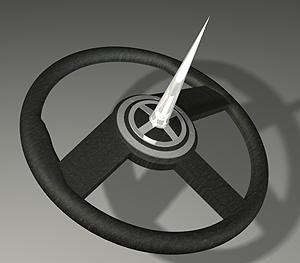
The solution of course is simple. Many people have suggested it, but it's politically incorrect to manufacture such a device. Strip the car of everything but the drivers instruments and possibly the radio, and fit a huge, micro-tipped chrome spike to the steering wheel. I guarantee road accidents would plummet and road safety would skyrocket.
And so to really badly designed cars
It seems to me that the big auto manufacturers have taken leave of their senses in the last few years, and have mastered the ability to build some truly terrible cars.
Anyone remember the 2004 Oldsmobile Alero? It seems like an unassuming car from the outside, but when you drive it....well. Where to start? The 'A' pillar was enormous. It was like an elephant's trunk. The result is that it obscured massive amounts of the driver's view of the road.
The doors. Very odd. They didn't open quite far enough, and had a vicious snap-back mechanism capable of re-closing the door on an unwary occupant who was trying to get out.
Then there's the traction control system. This was a modern marvel. When it was on, it took a good one or two seconds to realise you'd lost traction. And when it was off - well - actually you couldn't turn it off. There was a button that claimed to turn if off, but if you spun the wheels for more than three seconds, the car "decided" to turn traction control back on. Why?
Seemingly simple things like the trip meter reset button; it was on the dash, tucked behind the steering wheel out of sight of the driver. Should you try to find it and use it when you were actually driving - well - you couldn't.
Still, there's a glimmer of light at the end of the tunnel. GM finally killed off Oldsmobile in 2004 - cars designed by octagenarians for octagenarians. At least we won't have to deal with those dangerous eyesores for much longer.
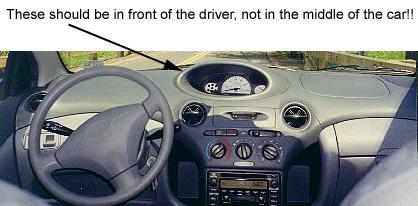
What about the instrument clusters? There's a worrying trend in vehicles now to put the instrument cluster in the centre of the dashboard instead of in front of the driver. Renault have been doing this for years, and the new Mini and some of the new Toyotas have it too. It's not a design thing - it's so that the manufacturers only have to have one set of parts for left-hand and right-hand drive cars. In these vehicles, to see your instruments, you have to deflect your view far more than normal, rather than just flick your eyeline down as you would in a normal vehicle. Your attention as well as your line of sight is off the road completely as you look to the middle of the car to see your speed (or whatever).
It's not just American cars either. European manufacturers get in on the act too. Vauxhall love to make super short stalks for the indicators and windscreen controls. You can't reach them with your hands on the wheel - you have to reach around the back of the steering wheel to use them. Even if you could just reach them with your fingertips, the ends of the stalks are gloss, black plastic, so there's nothing to grip.
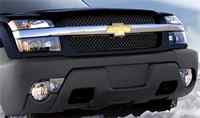
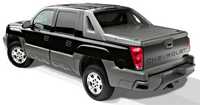 Its not just the details that amaze me. In some cases, it's the brazen in-your-face design that just slaps you so hard that you have to say "what the heck?"
Its not just the details that amaze me. In some cases, it's the brazen in-your-face design that just slaps you so hard that you have to say "what the heck?"
Take the Chevy Avalanche. That thing must have been designed by a cubist. Look at it. It's hideous. The square arches over round wheels, the acres of black tupperware girdling the bottom of the truck. The 'face' of the truck - did the designer have no sense of proportion or pride? People remember the front of a vehicle. In this case, swathed in plastic and with those horrible square-ish headlights. It's awful.

 Further design tomfoolery can be seen in vehicles such as the Nissan Quest (are Coca Cola going to sue them for misuse of the Coke 'Wave' shape), and the abhorrent Infiniti FX. Good Lord would you look at that thing? The wheels are too big, for a start, and the football-field of metal under the side windows is just vile.
Further design tomfoolery can be seen in vehicles such as the Nissan Quest (are Coca Cola going to sue them for misuse of the Coke 'Wave' shape), and the abhorrent Infiniti FX. Good Lord would you look at that thing? The wheels are too big, for a start, and the football-field of metal under the side windows is just vile.
But the grand daddy of truly hideous vehicle "design" has to be the Pontiac Aztek:

The exterior of this vehicle is just wrong on so many levels, I don't know where to begin. Again the massive wad of metal under the side windows. The double-stacked nose that so many vehicles are coming out with nowadays (who thought that looked good?). The shunted-up rear end that looks like the designer got 75% of the way through the design and then left the company.
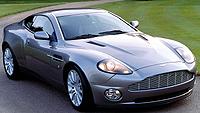
 What happened to beautiful cars? Some people still make them - the Aston Martin Vanquish is proof of that. And old-school manufacturers used to make them - look at the 1960s Ford Mustang. Have the manufacturers now decided that utilitarianism is more important than style? Do they think people want to be safe but could care less what the vehicle that they're driving looks like? I wonder if its the massive asset-guzzling of certain companies which is making this problem worse rather than better? Go to the GM website and you'll see that they now own Chevy, Pontiac, Oldsmobile, Cadillac, Buick, GMC, Saturn, Hummer, Saab and Opel. Go to the Ford website and you'll see that they own Ford, Lincoln, Mercury, Mazda, Volvo, Jaguar, Land Rover and Aston Martin. So much for choice and variety. Bascially, 95% of us are driving around in either a Ford or a GM by any other name. Is nothing sacred? Ford owning Aston Martin for chrissake? That's like - like - like - damn it's so bad I can't even think of a simile to describe it! (Or is that a metaphor?)
What happened to beautiful cars? Some people still make them - the Aston Martin Vanquish is proof of that. And old-school manufacturers used to make them - look at the 1960s Ford Mustang. Have the manufacturers now decided that utilitarianism is more important than style? Do they think people want to be safe but could care less what the vehicle that they're driving looks like? I wonder if its the massive asset-guzzling of certain companies which is making this problem worse rather than better? Go to the GM website and you'll see that they now own Chevy, Pontiac, Oldsmobile, Cadillac, Buick, GMC, Saturn, Hummer, Saab and Opel. Go to the Ford website and you'll see that they own Ford, Lincoln, Mercury, Mazda, Volvo, Jaguar, Land Rover and Aston Martin. So much for choice and variety. Bascially, 95% of us are driving around in either a Ford or a GM by any other name. Is nothing sacred? Ford owning Aston Martin for chrissake? That's like - like - like - damn it's so bad I can't even think of a simile to describe it! (Or is that a metaphor?)
Huge engines, terrible performance, appalling gas mileage.
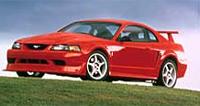 The door swings both ways though, and it seems to hit the designers and the enginemakers on the arse either way. Look at the current Ford Mustang. Fantastic car to look at. Guzzles fuel like it is water and can't drive in anything other than a straight line. So close, yet so far.
The door swings both ways though, and it seems to hit the designers and the enginemakers on the arse either way. Look at the current Ford Mustang. Fantastic car to look at. Guzzles fuel like it is water and can't drive in anything other than a straight line. So close, yet so far.
It never ceases to amaze me how the US car manufacturers are able to build such massive engines with such little power and performance, and such high fuel consumption figures. I think they must have some of the smartest minds in the country working for them, because you really have to be trying hard to make that combination. I mean large engines typically have large power. Not in the US. Large engines tend to be fuel efficient. Not in the US.
A colleague of mine recently bought his wife an Audi TT. This has a 1.8 litre engine in it which is turbocharged. He could not believe the power and handling of it compared to his US-built FordChevyGMC. Then the gas-mileage. How could it have so much power and consume so little fuel?
When I tackle people about this particular question, the inevitable answer is "American cars, engines and transmissions are designed for comfort, not performance."
How can you have a sense of comfort when you drive a car that has a 6-litre V8 engine it, that has such a remote feel to the accelerator that you have to concentrate to tell if the engine is actually on and doing anything?
If I stomp on the accelerator of my Subaru Impreza 2.5RS, it takes off like its arse is on fire. If I do the same thing in my friend's 2004 Chevy Impala, a vehicle with twice as many cylinders and three times the capacity, it growls and has a lovely throaty sound, but accelerates like the Queen Mary (whilst no doubt guzzling 6 times as much fuel).
The suspension on these vehicles is boaty and remote. The steering is so overpowered that you actually have to steer many American cars in a straight line. Let go of the wheel and the car will start to meander all over the road, eventually ending up on its roof no doubt as the power steering efficiently tries to make a 90 degree turn at 70mph.
Things looked up with the Cadillac Catera a few years back. The marketing blitz was "The Caddy That Zigs". I drove one. It had the handling of a 1970's European car, yet it was cutting-edge by American standards.
How is it possible with so many imported German, Swedish and Japanese cars, that the US manufacturers can still get away with these sorts of boaty, lousy, wallowy fuel-thirsty vehicles? It's not like the public are uneducated. The aforementioned imports have seen to that.
7/70 warranties and tip angles
According to the US motor vehicle testing system, it's actually okay for an SUV to have two wheels leave the ground in an emergency maneuver. I suspect then, that the much-touted 7/70 warranties on Jeeps and the like is a guarantee that they will roll 7 times when you swerve to avoid something at 70mph.
I know the reason for the sheer volume of rollover crashes in America. It's the power steering. In line with the nanny-car mentality, clearly we're all weak and feeble, and it's the car designer's responsibility to remove the hassle of heavy steering. Ok, this is fine at low speeds - power steering is a great feature when you're parking, or turning at low speeds. But it needs to be moderated. We don't need turbo steering pumps operating at full capacity when we're on the motorways. Last time I drove a Ford Taurus, the power steering was so light that I had to steer the car in a straight line at 70mph. It was the most exhausting drive of my life. Every time I loosened my grip on the wheel, the tyres found a tiny rut in the road, the over-eager power steering kicked in and we were off, weaving left or right.
Imagine that same system when someone doses off, is distracted by the in-seat video, is putting on their makeup, reading their annual reports etc, and they realise that they're actually in a car and that to avoid ramming the truck in front of them, they need to change lanes. Jerk-reflex, yank the steering wheel to change lanes. Power steering is at maximum, even though they're doing 70mph. A simple touch of the wheel spins the front wheels of the car to full lock. The car starts a violent turn which flicks the back end out. Once the car has started to slide and is at about 30° to the direction of travel, those front wheels are now at 90° to the direction of travel. They dig-in, the momentum high-sides the car and it goes into a roll.
This could all be alleviated by a simple design change - speed-sensitive power steering. Full power at standstill, to zero power steering once you're above 40mph.
Here endeth my musings on the subject of the various foibles of car design and manufacture. All comments are truly welcomed.
